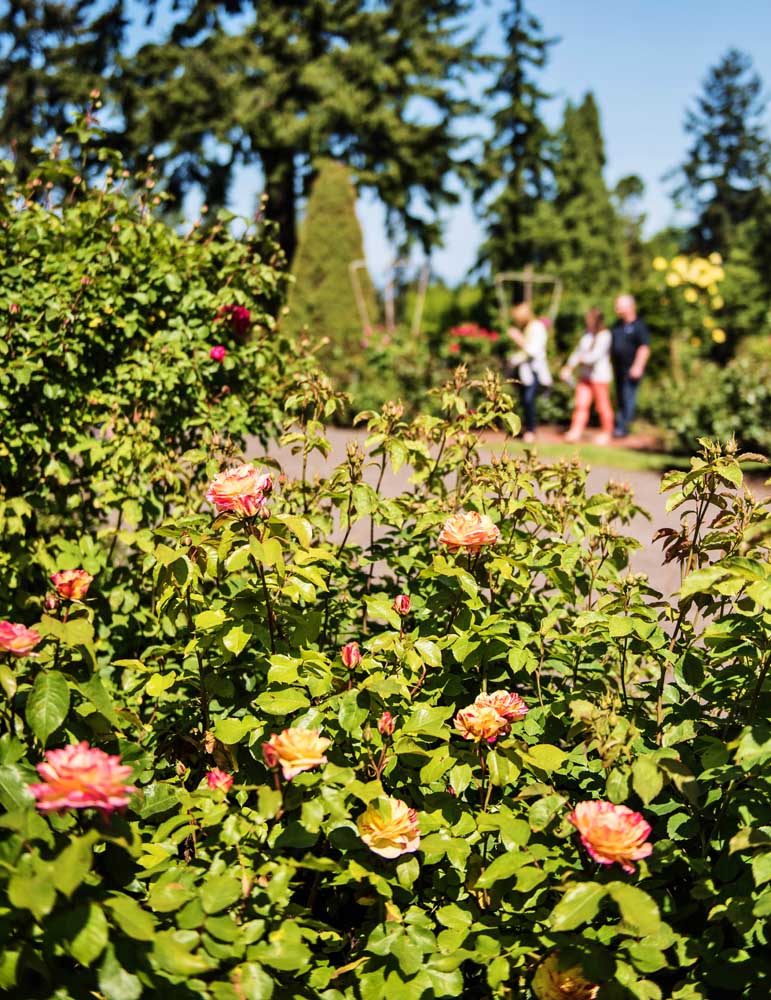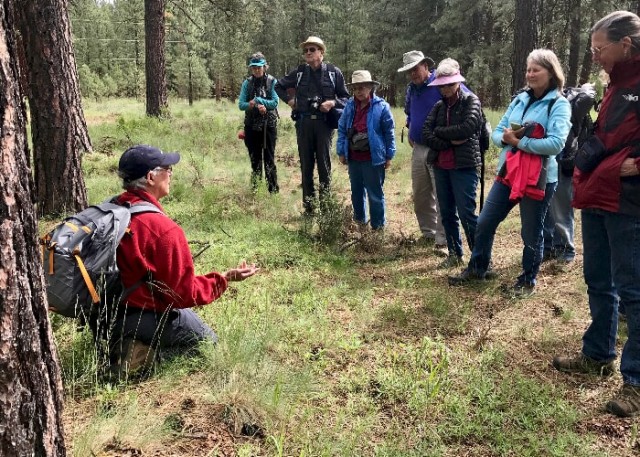A Mother’s Day tour of Oregon gardens
Published 12:00 am Sunday, May 10, 2015

- Bulletin file photoStop and smell the roses during the 128th Annual Spring Rose Show June 9 and10 at the Lloyd Center in Portland.
{%comp-FFFFFF-br%}
PORTLAND — It’s Mother’s Day. I hope you gave a dozen roses to your mother — or to the mother of your children.
Trending
If you were in Portland right now, you could stroll through the International Rose Test Garden and get a pretty good idea of the variety of roses from which to choose. Established in 1917, the 4½-acre Washington Park garden is the oldest test garden in the United States, boasting more than 7,000 bushes of 550 varieties.{%pl-3819251%}
And the Rose Test Garden isn’t the only colorful garden in Portland or the fertile Willamette Valley. Not by a longshot. Between the first peeks of crocuses and daffodils in the spring, and the last gasp of bright orange pumpkins in the autumn, the landscape bursts with color. Even in the rainy days of winter, various shades of evergreen contribute an emerald glow.
The Portland Japanese Garden and the Lan Su Yuen Chinese garden are cultural icons. The Crystal Springs Rhododendron Garden in southeast Portland is spectacular in spring. Peninsula Park, the Leach Botanical Garden and Elk Rock Garden of the Bishop’s Close are all worth visits.
If you’re in the Salem area, Silverton is home to the 80-acre Oregon Garden. In the same vicinity are the Adelman Peony Gardens and Schreiner’s Iris Gardens, both of which are at their peaks in May and early June.
Prime time
May, June and July are prime time for roses, the sweet-smelling flower that has led Portland to become known as the Rose City. The annual Portland Rose Festival has been an integral part of city life since it was first held in 1907. This year’s festival is scheduled to begin on May 22, with its signature Grand Floral Parade climaxing the celebration June 6.
Trending
By that time, Portland will know which bloom has been judged its best overall rose of 2015. In recent years, yellow has been a favorite of judges and visiting flower lovers. The Sparkle and Shine (2014), Monkey Business (2012) and Walking on Sunshine (2011) roses all share a similar golden color.
You’ll find them in the Rose Test Garden along with such other winners as the fragrant white Sugar Moon (2013), the creamy-pink Dick Clark (2011) and the orange-and-gold Strike It Rich hybrid (2010). Other past award winners also carry unusual names, such as Wild Blue Yonder, Rainbow Sorbet and Girls’ Night Out.
Judges rate the roses based upon 11 attributes. As reported on the garden’s website, these include the attractiveness and abundance of its blooms, its proportion of foliage, its fragrance, its hardiness and its resistance to disease.
Spring arrived early this year, so sections of the garden are already in full bloom. But most roses won’t truly burst out until next month. They will blossom into October.
One plot that is already showing its colors is the Royal Rosarian Garden, which displays the namesake roses of the “prime ministers” of the Order of Royal Rosarians, a civic group that has served as official greeters and goodwill ambassadors for the city of Portland since 1912.
Elsewhere, gardeners are tending dainty miniature blossoms as small as one-half inch in diameter, and flourishing giants up to 8 inches across. A perennial favorite of garden visitors is the Shakespeare Garden, featuring flowers, trees and herbs mentioned in the plays of circa-1600 playwright William Shakespeare. On a memorial wall, surrounded by roses named for the Bard’s characters, is a plaque with the image of Shakespeare and this quote: “Of all flowers, methinks a rose is best.”
There’s no admission charge to visit the Rose Test Garden, although parking might be hard to find. It’s worth it, though: The view of snow-covered Mount Hood rising beyond Portland’s downtown skyline, with scores of roses in the foreground, is hard to beat.
In the adjacent Rose Garden Store, you might not find Sugar Moon or Monkey Business, but you will view a great deal of rose-themed merchandise, from silk flowers to rose-patterned tea sets. Proceeds from sales benefit gardens and urban youth recreation programs.
Japanese Garden
A short walk uphill is the 5½-acre Portland Japanese Garden, widely considered to be the most historically genuine outside of Japan. Commissioned by the Portland City Council to bridge the East-West gap with its sister city of Sapporo, the garden was built over four years by Japanese landscape architect Takuma Tono and opened in 1967. {%pc-3819257%}
Five complementary styles of traditional gardens constitute the Japanese Garden. Visitors walk beneath a wisteria arbor and past a five-tiered pagoda to enter the Strolling Pond Garden. A curving Moon Bridge crosses a long water feature, populated with koi fish, to reach the Tea Garden. At its heart stands a traditional tea house, a “chashitsu,” where monthly ceremonies are performed. The cherry trees and azalea plants of spring give way to flamboyant irises in summer and to lace-leaf maples, their leaves glowing orange and red, in fall.
Uneven stone walkways and a zigzag bridge open into the Natural Garden, where delicate camellias, azaleas and rhododendrons are in blossom. Many visitors choose to linger in this area, which feels wilder than others. It leads into the Sand and Stone Garden, a dry landscape of stark gray rocks rising above carefully raked white pebbles. From there, stone stairs climb to the Flat Garden, which represents the four seasons and is best-viewed from a central pavilion. A century-old cherry tree symbolizes spring; cooling rocks, summer; a vine maple, fall; and a pine tree, winter. {%pf-3819249%}
Adult admission is $9.50. Guided tours are offered three times daily for no additional charge. There’s a little garden shop that stocks books on such topics as “ikebana,” the art of Japanese flower arranging, and traditional tea ceremonies.
One art exhibit in the garden’s Pavilion Gallery has just come to a close, but another — “Kizuna: The Rebirth of Mashiko Ceramics” — will run from June 6 through July 5. The exhibit will highlight the resilience of the historic pottery town of Mashiko, where artists regrouped after the devastation of the 2011 earthquake to rebuild their kilns and carry on their traditions.
Chinese Garden
Portland’s classical Chinese garden, known as Lan Su Yuan, is located in the heart of the city’s Chinatown. The Chinese name translates to “Garden of the Awakening Orchid.” Built in 1999 and 2000 through a partnership between Portland and Suzhou, its Chinese sister city, the garden is an inner-city oasis of beauty and serenity, ringed by tall buildings.
Well-known for its compact, intricate urban gardens, Suzhou sent designers and artisans to Oregon to build an authentic Ming Dynasty garden that occupies a city block. Walkways lead through keyholelike portals, into quiet courtyards and pavilions with such poetic names as “Painted Boat in Misty Rain” and “Celestial House of Permeating Fragrance.” Views through windows, doors and elaborateginkgo-wood lattice screens assure that a visitor’s perspective is constantly changing. {%pr-3819245%}
From a two-story teahouse called the Tower of Cosmic Reflections, a garden panorama takes in 500 tons of imported limestone, meticulously arranged to resemble small mountains. Waterfalls tumble through rocks and stunted pines into Zither Lake, where a zigzag bridge leads to a pavilion that frames the full moon. All of the garden’s nine buildings carry the Chinese symbols for health, wealth, long life, virtue and happiness, baked into their roof tiles.
Adult admission is $9.50. Free 45-minute public tours are offered several times daily and frequently end at the teahouse, where a menu of teas and light Chinese foods is offered. Among many books for sale in the Garden Shop is “Listen to the Fragrance,” an interpretation of the design philosophy behind Chinese gardens.
You can also learn to play Chinese games such as mah jong and go, take part in traditional fitness classes, or attend lectures and demonstrations of Chinese food and medicine, music and calligraphy. Continuing through May 31, the “Impressions of China” photography exhibition showcases the work of 13 American artists who took part in a cultural exchange program early last year. {%pr-3819242%}
Crystal Springs
Far too often overlooked is the Crystal Springs Rhododendron Garden, just across Southeast 28th Avenue from Reed College. Mother’s Day falls in the heart of its most colorful season, when more than 2,500 rhododendrons and azaleas blossom across the 9½-acre grounds. Many of these flowers are rarely seen in the Pacific Northwest.
Visitors pay $4 to walk through the entrance gate and down a ramp or a set of steps to a curving bridge, which crosses a waterfall-fed stream. A good-sized lake is a year-round home to colonies of waterfowl and other birds; nearly 100 species have been seen here, according to garden literature. Japanese maples, sourwood trees, fothergilla (witch alder) and many other plants add year-round color.
If you happen to be in Portland today, you’ll find the biggest rhody show of the year taking place at Crystal Springs between 9 a.m. and 5 p.m.
The Portland chapter of the American Rhododendron Society oversees a second garden, the Cecil and Molly Smith Garden, near the Marion County village of St. Paul, between Newberg and Woodburn.
Also in Portland
Admission is free to enter three other small gardens in various parts of Portland.
North of Killingsworth Avenue, Peninsula Park was designed as a neighborhood park between 1909 and 1913. Its stone pillars and brickwork, lantern-style street lights and century-old fountain attest to the historical flavor. Portland’s first public rose garden, still neatly manicured, is spread out here, along with the city’s first community center, its second playground and a historical bandstand. Before the turn of the 20th century, the park grounds held a quarter-mile ring for horse racing. {%pl-3819259%}
The Leach Botanical Garden covers 15 acres on both sides of Johnson Creek in southeast Portland. It was started in the early 1930s by John and Lilla Leach, she a well-known amateur botanist. The garden emphasizes native Northwest plants, with more than 2,000 species. The various habitats represented here include a sunny lava-rock garden, a shade-tolerant medicinal garden, groves of barberries and woodland lilies and a moist woodland environment. There’s also an extensive home-composting demonstration center.
Overlooking the Willamette River in the exclusive south-end Dunthorpe neighborhood, the Elk Rock Garden of the Bishop’s Close surrounds the headquarters of the Episcopal Diocese of Oregon. The 13-acre estate was built in 1914 by merchant Peter Kerr, who recruited New York landscape architect John Olmsted to lay out the property.
Kerr then created his personal garden. Today it appears much as it did in 1957, when Kerr died at age 95 and his daughters donated it to the church. Around the property are 35 flowering magnolia trees, numerous varieties of witch hazel, wisteria, mulberry and numerous other native and rare plants. Trees include ancient ginkgo and dawn redwood, as well as giant sequoia, maple, birch, cypress, cedar, fir, yew, sassafras and madrone. There is an exquisite terrace garden, a large rock garden, lily ponds, a landscaped watercourse fed by a natural spring and a formal boxwood-hedged terrace.
The Oregon Garden
At the edge of Silverton, east of Salem, is the 80-acre Oregon Garden, built in 1999 by the Oregon Association of Nurseries. A stunning achievement in horticultural choreography, the garden occupies a sloping wetland created from recycled treatment-plant wastewater.
From the blossoming lotuses in its mazelike water garden to the Alaskan weeping cypresses of its conifer display, the Oregon Garden features more than 20 individual gardens, presenting samples of Northwest and Willamette Valley landscapes, drought-tolerant plants and ornamental shrubbery. One garden displays pet-safe foliage; another beckons children to make botanical discoveries. In a sprawling oak grove stands a white oak determined to be more than 400 years old. {%pl-3819255%}
Horticulture manager Heather Desmarteau-Fast said any month is a good time to visit the Oregon Garden, “but I would definitely come to the garden in August or September,” she said. “You have the annual color, as well as vegetables and fruit, and a lot of growing activity. This is prime time.”
Adjoining the garden, the Oregon Garden Resort offers a moderately priced option to stay overnight beside the blossoms.
The resort has 103 rooms in a series of out-buildings that resemble private vacation homes. Rates start at $109 a night. In the Craftsman-style main lodge building is a full-service spa, a lounge with nightly music and the bi-level Garden View Restaurant, which serves three meals daily. {%tr-BDBDBD, 000000, 3%}
Those who stay in the Oregon Garden Resort can walk into the garden at any time — through a back gate. That means the $11 main-gate admission fee is waived, and the usual 9 a.m.-to-6 p.m. entry hours are ignored.
On the opposite end of the grounds is the only publicly accessible, Frank Lloyd Wright-designed house in the Pacific Northwest. The 1957 Gordon House is a classic example of the architect’s horizontal style, with 12-foot, floor-to-ceiling living room windows that bring the outside environment indoors.
Completed in 1963, four years after Wright’s death, it was constructed for a Wilsonville farm couple on a plot near the Willamette River. But when the new owners of the house announced plans to raze the building, the Frank Lloyd Wright Conservancy moved it 21 miles to its current site in 2001.
It was listed on the National Register of Historic Places three years later. Tours of 45 minutes, beginning hourly from noon to 2 p.m., are priced at $15.
— Reporter: janderson@bendbulletin.com
{%ssc-3819241,3819243,3819247,3819250,3819252,3819253,3819258,3833576%}








